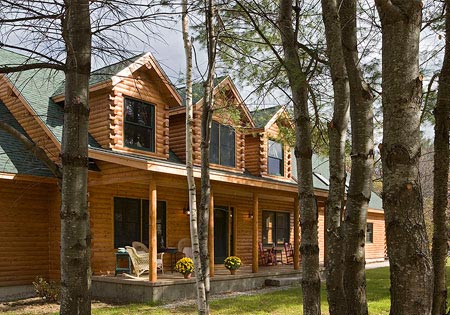Log Home Glossary
Posted by Ward Cedar Log Homes in Log Homes
As you begin to explore building a log home, you will run across words and phrases that you may not recognize. This log home glossary contains many of those words and their definitions. If you have any other words that you would like a definition for, please contact us and we will add them to this log home glossary.
Air-dried logs – Natural drying process (exposed to air) to get the moisture content down to a rate of 15-19% in the logs.
Anchor Bolt – A threaded rod or bolt embedded into the concrete to bolt the sill plate to the foundation or slab.
Backer Rod – Small round foam used to fill the joints between the logs. Reduces the use of sealant and allows for the caulking expand and contract and not pull away from the logs.
Balusters – Also called spindles that are vertical supports for the railing.
Board Foot – Unit of volume for timber equal to 144 cubic inches, a piece of wood that measures 12 inches wide x 12 inches in length and 1 inch thick. Abbreviations can be BDFT or BF.
Butt Joint – The joint where two pieces of log meet at a 90 degree angle.
Butt and Pass – Term used to describe the corners, where the logs alternately extend past one another instead of square log ends butting against the face of each other.
Caulking – Flexible material that fills up to ¼” gap. Normally used for between the logs, around the purlins, and around the windows/doors.
Check – Natural occurrence in wood that produces small cracks when dried.
Chinking – Filler used to cover large seams between rows of logs. Usually up to an inch gap.
Collar Tie – Horizontal board used to prevent the roof framing from spreading or sagging.
Course – One complete row of logs around the building.
Dado – Groove cut into the log so another log can fit into it.
D-Log – Log profile where one side of the log is rounded and the other side is flat. The log resembles the shape of a capital D.
Dormer – Framed projection in a sloping roof.
Drip Edge – A lip at the bottom of the log where water will hit and drip off.
Dry-in – Generally includes the materials required to get a home to the “dry-in” stage or weather-tight.
Exposed Rafters – An exposed beam in the home that extends from the ridge beam down to the eave.
Eave - The part of the roof that overhangs the walls of a building to provide protection from the weather.
Fascia – Finish board that is applied to the edge of the roof on the eaves and gables.
Fastener – Hardware used to connect or anchor timbers.
Flashing – Waterproof materials used to protect joints from moisture. Used around windows/doors, chimneys, where roof intersect (valleys), and used along the inner edge of decks and porches.
Foam Gasket – Water resistant foam materials that is used between the logs to prevent air and water infiltration. Used along the tongue and groove of the log wall system.
Gable – The vertical triangular end of a building.
Girder – Horizontal member that is designed to carry heavy loads. Usually found in the floor framing.
Hand Hewn – Working a log with a draw-knife to give it a rough look.
Header – Beam that supports a load suspended over an opening such as windows or doors.
Hybrid – A mix of building styles or components. For example, a 2x6 framed constructed home with log siding to mimic the look of real logs or the use of heavy timbers.
Linear Foot – Is one foot in length or 12 inches.
Log Grading – Process where logs are inspected and graded to determine the overall quality using set standards.
Log Profile – The shape of the log when viewed from its end.
Log Screw – Self driving screw used to secure the logs together.
Log Siding – Milled from lumber that is machined to have a log appearance.
LVL - Short for Laminated veneer lumber, is an engineered wood product that uses multiple layers of thin wood assembled with adhesives. Typically used for headers, beams, and rimboard. It is stronger and straighter than traditional lumber.
Mill Glaze – Shiny like film that develops on milled lumber during the production process.
Milled Logs – Logs that have been shaped by a machine to a uniform size and shape as opposed to handcrafted logs.
Purlin – Heavy timber horizontal member spanning perpendicular to a roof system. Runs from gable to gable.
Pre-cut – Extent to which the logs are notched and cut to specific lengths.
Ridge Beam – Structural member used to support the ends of rafters at the ridge and carry the roof load along the walls.
Rough Buck – Wooden frames that provide rough opening and structure into which doors or windows will be installed.
Rough Opening – An opening that is slightly oversized in a wall to accept a window or door.
R-value – The capacity of an insulating material to resist heat flow. The higher the R-value, the greater the insulating power.
Sheathing – Plywood or OSB that is installed over outer studs, floor framing, and roof system.
Shell Package – The basic structure of a log home that consists of the log walls. They can also consist of the entire outer structure of a log home including the sub-floor system, log wall system, second-story floor system and roof system.
Soffit – The boards applied to the underside of a roof’s overhang or eave.
Structural Insulated Panels (SIPs) – High performance panels that are made up of insulated foam core then sandwiched between OSB. These panels can be used for floors, walls, or roofs.
Subfloor – A rough floor over which a finished floor, flooring material, or carpet is laid.
Thermal Mass – The ability to absorb and store heat energy. This feature along with the natural insulation of wood is what makes log homes energy efficient.
Tongue & Groove – Wooden planking in which adjacent boards are joined by means of interlocking ridges and grooves on their sides.
Turnkey – A Home that is ready for immediate use.
U-Factor – A measure of the heat transmission through a building part such as a window or door with lower number indicating better insulation properties.
Wane - A defect in a board or log characterized by bark or insufficient wood at a corner or along an edge, due to the curvature of the log.
Wood Preservative – Specialized formula to protect wood from the deteriorating effects of wind, rain, and sunlight, and prevent attacks by fungus, mold, mildew, and insects.
Ready to start planning your dream log home? View our log home floor plans or give us a call at 800-341-1566 to discuss the possibilities. Or drop us an email.


Post Your Comment